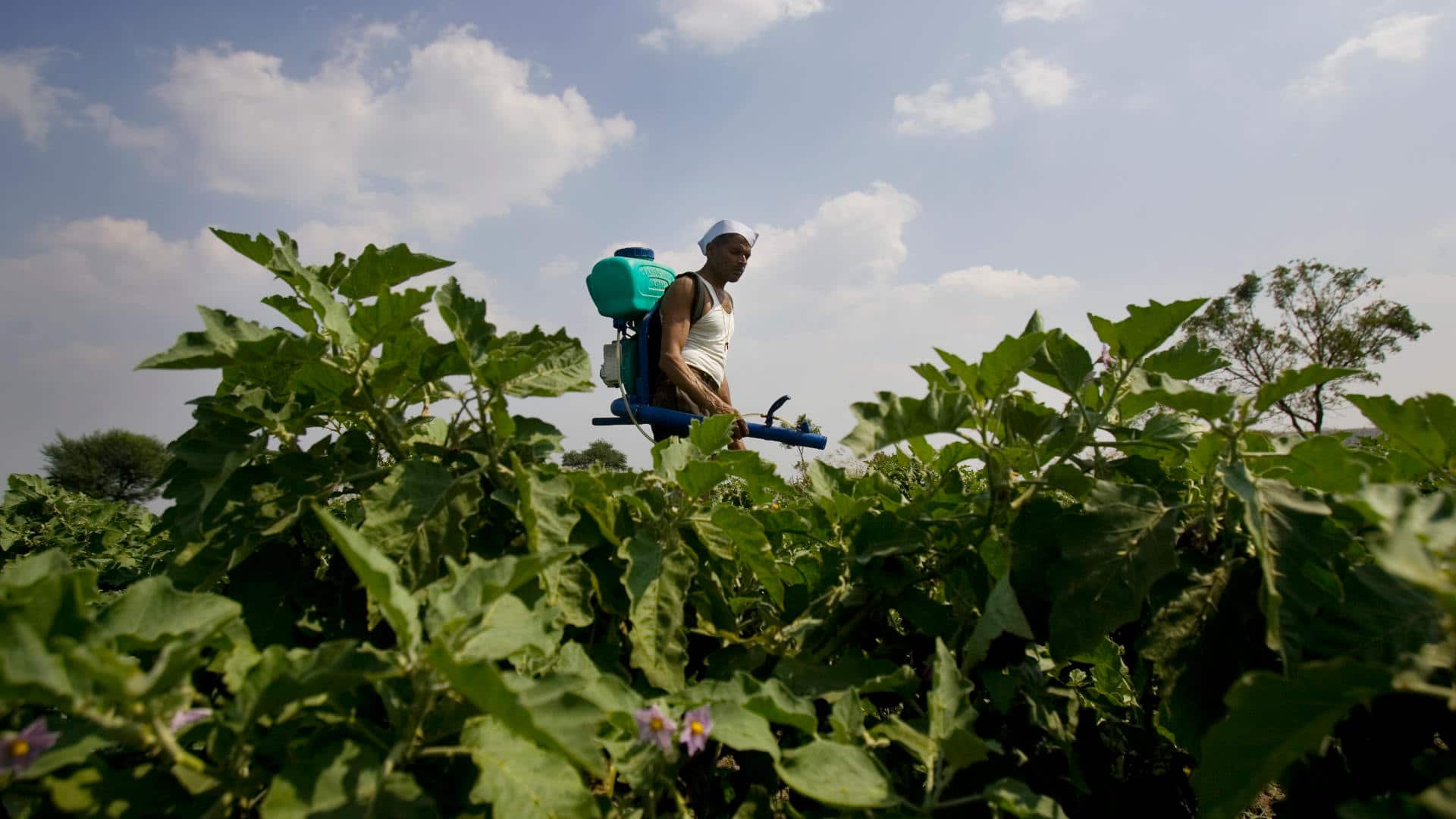For India’s Millions of Farm Workers, a ‘Drone Revolution’ Looms
On a sweltering October afternoon, Hardeep Sharma, 39, hauls a 40-liter portable petrol engine on his back to spray insecticide across a 3-acre sugarcane field. He isn’t satisfied: This is the only work he’s gotten in the past two weeks.
Sharma is from Bihar, one of India’s poorest states. But he’s earned a decent living as a migrant agricultural laborer since moving to the northern state of Haryana 12 years ago. Haryana’s agricultural sector relies on hundreds of thousands of Bihari laborers, and in the small village of Ghuskani, where Sharma lives, more than 87 migrant laborers work in fields, clean cattle sheds, and perform factory jobs.
This story was originally published by Slate and is reproduced here as part of the Climate Desk collaboration.
Sharma has sprayed insecticides on practically every farm in the village over the past 12 years. But recently, he’s been unable to get spraying work. The reason? Many landowners have turned to agricultural drones. “My livelihood is almost over since drones arrived in this village,” he says. “I basically sit around doing nothing.”
There are plenty of bold predictions that drones will be the future of farming. They are far quicker at chemical spraying, adaptable to a wide range of farm duties, and can aid with water conservation. But above all, they are praised for cost-efficiency. At a drone festival in 2022, Indian Prime Minister Narendra Modi said it was his dream to see a drone on every farm — they would be a game changer for the agricultural industry, he declared. In India, agriculture accounts for about a fifth of the national GDP.
“My livelihood is almost over since drones arrived in this village.”
Just 100 yards from the field where Sharma was spraying, Satya Pal Singh, 62, a major landlord with 35 acres of land, carefully peers at a remote control while a huge agricultural drone hovers over his sugarcane field, spraying insecticides. Singh is one of the farmers who used to hire four or five laborers like Sharma to spray for about a week. But now he prefers to pay a drone operator, which he says costs twice as much but gets the job done in one day. “The pilot does everything. All we need to do is give him insecticide,” Singh says.
Some 50 yards from Singh’s farm, Ajay Kumar, 37, says he almost gave up farming on his 20 acres of land — but the introduction of drones has helped turn things around. Whereas it used to take a laborer seven or eight hours to spray an acre of land, a drone can cover the same ground in eight or nine minutes, Kumar says. Previously, when disease spread in his field, Kumar found it impossible to quickly hire laborers. If he did find them, by the time they finished spraying insecticides, the disease had already spread across his crops.
Depending on the kind of sensor they’ve been armed with, drones can do a lot more than spray chemicals. Some can analyze the terrain for weeds, check moisture levels, assess for signs of pest infestation, suggest field planning, determine crop health, and even create a nutrient map of the growing harvest.
But buying a drone is no small endeavor, even for financially sound farmers, and renting it out is also fraught with risks. A battery-powered drone costs the equivalent of $8,000, whereas a petrol-powered drone costs about $15,000 —and there are also insurance and damage fees to consider.
In part because of these costs, drones are still part of a nascent industry in the country, and uptake is comparatively slow. As of November, there were around 13,000 drones registered in the country, though not all are used for agriculture. By comparison, the most recent census data, from 2011, estimated that the country had nearly 263 million agricultural laborers.
The industry also remains mostly unregulated. “Just like the consumer electronics market, there is going to be cutthroat competition in the agricultural drone segment. But we’re talking about agriculture, the backbone of the Indian economy,” said Vasant Bhat, founder and CEO of the agricultural drone company Trithi Robotics. “If we don’t do our due diligence and regulate the players … the drone revolution could end up doing more harm than good to the agriculture sector.”
As this transition tests its way through Indian farms, the potential consequences for agricultural laborers are profound. India has one of the world’s highest rates of farmer and farm laborer suicides, influenced by issues including debt burden, low financial growth prospects, frequent crop failures due to erratic climate changes, and an increasingly privatized market with few protections.
Ganesh Ram, 41, said he paid about $120 for a portable petrol engine sprayer similar to the one Sharma has—the equivalent of around 60 days’ salary. He used to spray for two months twice a year, once for the wheat crop and once for the rice crop. Before the drones, Ram said, he earned between $144 and $180 per spraying season. Now he earns less than $48 — both because work is harder to come by and because landowners use the threat of turning to drones to offer even lower wages.
Running out of options, Ram is now looking for alternative employment to support his family of six. He’s not alone. An assessment from India’s National Sample Survey Office found that close to 40 percent of Indian farm owners aren’t interested in pursuing their profession in the long run. Farm laborers are in a more precarious position — especially women, who are paid an average of 25 percent less than their male counterparts. More than 40 percent of agricultural laborers are women, according to a 2020-21 report from the government’s Ministry of Agriculture and Farmers Welfare.
Ramauti Devi, a 62-year-old mother of five, inherited a small tract of land from her deceased husband — but it’s barely enough to feed her family and start a new crop cycle. Debt still creeps in, so two of her sons work as seasonal farm laborers on a contract basis.
“The drone revolution could end up doing more harm than good to the agriculture sector.”
“I have seen flying machines spraying chemicals recently,” she says. “What will my sons do if [their boss] buys these machines to grow his crops?” Devi wonders if the person who operates the drones makes a lot of money and if one of her sons has a chance of learning to fly the craft.
Drone service providers say they intend to train laborers to pilot drones, especially those who have lost their jobs as a result of the transition. But the solution isn’t as straightforward as it sounds. Farm laborers are at the lowest tiers of the literacy ladder, and operating a drone requires proper training and licensing approval from the Directorate General of Civil Aviation, the government body tasked with regulating civil aviation in India. But even the DGCA asks for an application fee of around $12, in addition to mandatory training and exams from DGCA-approved drone schools. The training can last up to three months and cost anywhere from $360 to $1,200.
So, for now, workers like Sharma don’t have many options. Sharma has been visiting each farm owner in the village and requesting spray work. “If I don’t get it,” he says, “my children and wife will go hungry at home.”
Arbab Ali and Nadeem Sarwar are independent reporters based in Delhi, India.











